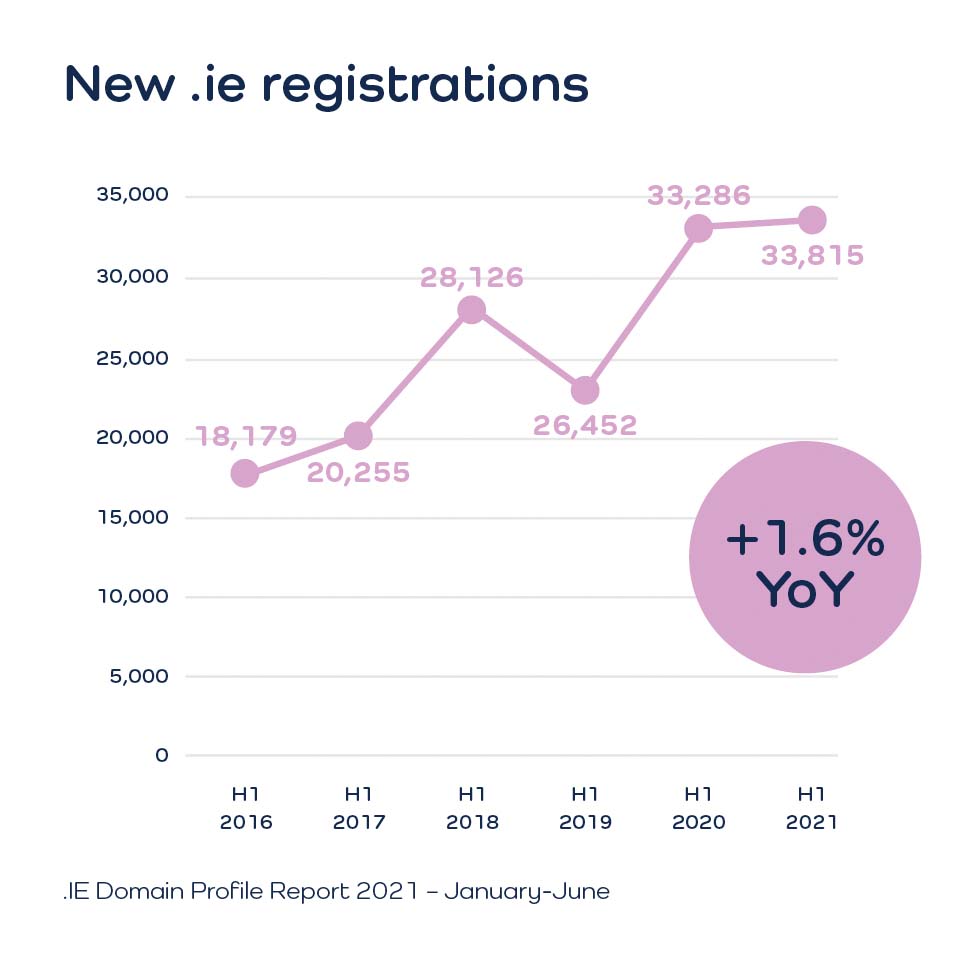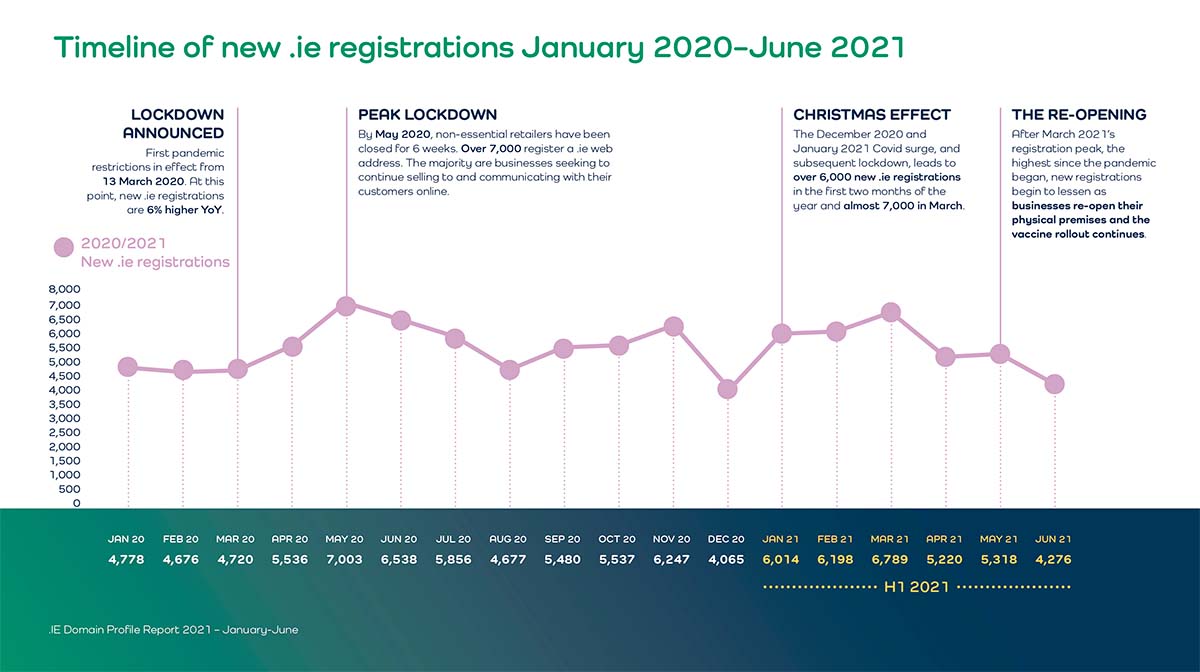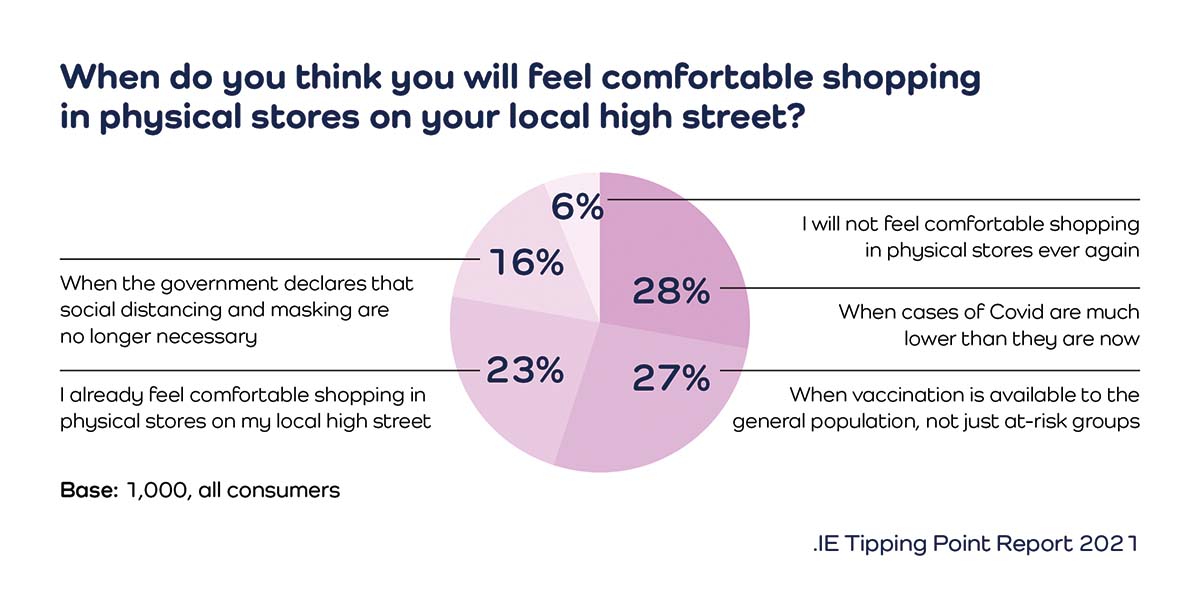Irish SMEs are adapting to new consumer behaviours

The pandemic is having a sustained effect on the .ie domain writes David Curtin, CEO of .IE, the company that manages .ie, the preferred online address for business in Ireland.
The latest .IE Domain Profile Report, which analyses and explores the .ie database, shows a clear correlation between the Government’s decision to lock down sections of the economy and changes in new .ie domain registrations.
33,815 new .ie domains were registered in the first half of 2021 (H1: 1 January–30 June), an almost 2 per cent increase on the same period last year, marked by the beginning of the pandemic in Ireland. H1 2021 is the best first half-year period on record for new .ie domain registrations.
This increase is also good news for the broader economy and its recovery. The CSO recognises domain registrations as a forward indicator of digital intent and future e-commerce activity.
At 51 per cent, the .ie domain holds the highest market share of all hosted top-level domain names in Ireland, ahead of .com with 32 per cent. Ireland, with 9.6 per cent growth year-on-year, is the second fastest-growing country code domain in Europe, behind Portugal at 10.8 per cent growth year-on-year. Authentically Irish and trusted at home and internationally, the .ie domain remains the domain of choice for Irish businesses and individuals.
Responsiveness and adaptability
In Q1 2021, during the post-Christmas lockdown, new registrations increased by almost 34 per cent year-on-year. Registrations continued upwards in January and peaked in March, at which point non-essential retail had been closed for three months. SMEs clearly recognised that a web presence was the only effective means of staying connected with customers or, indeed, staying open at all.
In Q2, registrations gradually slowed as non-essential retail re-opened and the vaccine rollout accelerated. Numbers, while still high, decreased 22 per cent compared to Q2 2020, the period of Ireland’s first lockdown.

Beyond correlation with lockdowns, the data suggests two major trends among SMEs in particular: greater responsiveness to consumer demands, such as useful digital experiences, including e-commerce; and increased understanding of the value of omni-channel.
While digitalisation was increasing in the years before the pandemic, historically SMEs have been slow to invest in their online presence. The 2019 .IE SME Digital Health Index showed that most small business owners, despite recognising the benefits of digital technology, and indeed using it themselves for purchasing and online banking, said they did not have the available time or skills to build a useful website to engage with their customers.
But the pandemic has created an ‘adapt to survive’ situation. Business owners affected by lockdown have had no other choice but to migrate their sales function partially or entirely online after the closure of their physical premises. Sceptics have seen what their competitors have accomplished in selling online, often with ‘click and collect’ and are responding by replicating this ‘bricks and clicks’ mix of in-store and online sales and marketing.
The .ie domain has provided SMEs with the means to quickly build an authentically Irish digital presence with a website and e-commerce functionality. Even SMEs that provide a service can, if the service type allows, provide video consultations, sell vouchers for future use, or at the very least build goodwill with customers. Estate agents and conveyancing solicitors have demonstrated that physical paperwork and bureaucracy can be eliminated by using digital tools combined with an effective .ie website.
Keyword analysis
Keyword analysis of words within the .ie domain name shows that SMEs continue to adapt quickly to the current environment and are using customised websites to meet consumer demand. There was an increase of 64 per cent in the number of new .ie web addresses with ‘outdoor summer’-related keywords in H1 2021, such as ‘pool’, ‘barbecue’ and ‘tent’ among other outdoor activities and hospitality products. General health-related keywords, such as ‘doctor’, ‘pharmacy’, ‘wellness’, and ‘fitness’ increased by 18.8 per cent. Homeware stores, garden centres, GPs and pharmacists, who may previously have been reluctant to invest in their online presence, are now benefiting from the convenience and revenue-generating power of online sales and virtual consultations.
Omni-channel
Even with the option to shop in-store, for convenience or price reasons many consumers now simply prefer to buy online or at the very least browse or research products online before buying them in-store.
The pandemic has greatly accelerated the trend towards omni-channel retail, whereby the process of buying and selling a product or service integrates digital and physical platforms. This is likely to become permanently ingrained behaviour and a core trend in retail generally.

We know from the latest .IE Tipping Point research (conducted January 2021) that less than a quarter of consumers felt fully comfortable shopping on the high street. While lockdown restrictions have since eased significantly, nearly 60 per cent of consumers said they intended to do some or all of their shopping online for the remainder of 2021. A rise in .ie domain registrations suggests SMEs are increasingly prepared for this reality.
Digital towns and the rural future
Since the pandemic, digital technology, coupled with improving internet infrastructure, has empowered individuals, businesses, and communities across the country in profound ways, opening new markets, creating new ways to participate in civic and local life, and enabling greater work-life balance.
This is especially true for regional Ireland, and especially promising. Businesses’ increased openness to remote and hybrid working has clear benefits for smaller towns with less commercial investment and fewer employment options.
Flexibility to work anywhere means a reduction in brain drain and even a ‘brain gain’ as workers from major cities are drawn to smaller towns and the countryside. Local enterprise offices can capitalise on this by investing in enterprise and digital hubs, providing central office spaces for innovation, collaboration, and other community events.

.IE has long recognised the potential of Ireland’s towns. In June, we announced the winners of our inaugural .IE Digital Town Awards, which marked the first phase of a €1 million investment that we will deliver over the next four years as part of our nationwide .IE Digital Town programme, which seeks to empower and celebrate digital towns.
What each of our winners, runners-up, finalists, and overall winner, Dingle Peninsula, showed was the resilience and spirit of local towns, local people, and local communities in creating their own opportunities by using digital for the betterment of local life and society.
The Government, too, now has a clear progressive vision for Ireland’s towns and villages. The Rural Development Policy, 2021–2025 outlines the steps to a digitally-enabled rural Ireland, empowered to strengthen rural employment and improve career opportunities for young people. Among its goals are the implementation of local digital strategies, the development of a new adult digital literacy strategy, and the creation of multi-purpose community spaces, involving renovating vacant or under-used buildings as enterprise hubs.
We believe that towns and communities around the country, empowered by local energy and insights, supported by the Government and industry programmes like .IE Digital Town, can continue to inspire others and show how digital technologies can create new, efficient ways of doing the right things locally, promote local innovation, and preserve and grow local communities.
E: marketing@weare.ie
W: www.weare.ie






